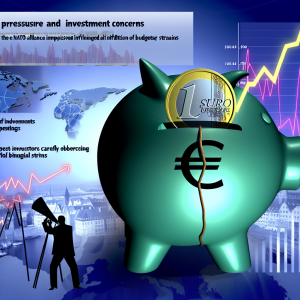Europe’s Military Spending Surge: What Investors Must Know Now
Europe is on the cusp of a significant shift in military spending, but the pace and scale will vary dramatically across the continent. According to forecasts from Scope Ratings, central and eastern European nations are ramping up defense budgets aggressively, driven by heightened security concerns. Meanwhile, southern European countries like Italy and Portugal, alongside fiscally constrained heavyweights such as France and Belgium, are adopting a much more measured approach. Spain’s recent decision to opt out of the latest NATO defense spending commitments underscores this growing divergence in threat perception and fiscal priorities.
Why does this matter for investors? Because rising defense expenditures come with a double-edged sword: increased government borrowing and deteriorating sovereign debt profiles. Scope Ratings highlights that beyond mere compliance with fiscal rules, the sustainability of government debt hinges on broader fiscal health—budget balances, interest payment burdens, and medium-term debt trajectories. Without offsetting spending cuts or revenue hikes, most EU countries will see weaker sovereign creditworthiness as military budgets swell.
The EU’s Bold Move: Centralized Defense Financing
Here’s a game-changer: the European Union is stepping into the breach with a centralized financing mechanism for defense and security. The Security Action for Europe (SAFE) initiative will provide a €150 billion credit line funded by EU-issued debt. This is not just a funding boost—it’s a strategic pivot toward deeper fiscal and political integration. SAFE loans come with attractive terms—up to 45 years maturity and a 10-year grace period on principal repayments—potentially lowering borrowing costs for member states.
This initiative will likely drive a surge in EU bond issuance, projected to reach €662 billion by mid-2025, and increase the share of the EU budget dedicated to interest payments, especially during the 2028-2035 multi-annual financial framework. For bond investors, this signals new opportunities but also heightened scrutiny on the EU’s fiscal sustainability.
Beyond SAFE, the European Defence Industry Programme (EDIF) is injecting €1.5 billion in grants through 2027 to bolster cross-border procurement and strengthen supply chains. Proposals for a European Rearmament Bank and a broader Defence, Security & Resilience (DSR) Bank are also on the table. These institutions would finance defense procurement and industrial expansion, potentially including non-EU NATO and Indo-Pacific allies, marking a novel form of transatlantic and global defense cooperation.
What Investors and Advisors Should Do Differently
-
Reassess Sovereign Risk Profiles: Investors need to factor in the uneven pace of defense spending increases across Europe. Countries accelerating their military budgets without clear fiscal offsets may face credit rating downgrades, impacting bond yields and risk premiums.
-
Watch EU Bond Markets Closely: The SAFE initiative’s bond issuance will reshape the EU fixed income landscape. Advisors should monitor yield curves and credit spreads for these new instruments, which may offer relatively stable returns backed by collective EU creditworthiness.
-
Explore Defense Sector Opportunities: With increased EU grants and financing mechanisms targeting defense procurement and industrial capacity, equities in European defense contractors and supply chain companies could see growth. This is a sector ripe for strategic exposure.
-
Prepare for Political-Economic Integration: The move toward centralized defense financing signals broader EU fiscal integration trends. Investors should consider the implications for currency stability, fiscal policy coordination, and the potential emergence of new EU-level financial instruments.
A Unique Insight: The SAFE initiative’s long maturity and grace period structure resemble a sovereign “green bond” in terms of investor appeal but focused on security rather than sustainability. This could attract a new class of institutional investors seeking stable, long-term returns with a geopolitical dimension—something we haven’t seen in traditional sovereign debt markets.
In fact, according to recent data from the European Investment Bank, green bonds have attracted over €50 billion in European investments annually. SAFE bonds could tap into similar investor pools, blending geopolitical strategy with financial innovation.
Looking Ahead: The Next Five Years
As Europe navigates these defense spending shifts, expect credit rating agencies to become more nuanced in their assessments, weighing geopolitical risks alongside fiscal metrics. The EU’s evolving financial architecture will create both risks and opportunities across sovereign debt, corporate bonds, and equity markets.
For investors and advisors, staying ahead means integrating these macro-defense spending trends into portfolio risk models and seeking tactical exposure to emerging EU defense financing instruments. The intersection of security and finance is becoming a defining theme of this decade—those who anticipate and act on it will gain a strategic edge.
Sources:
- Scope Ratings Sovereign Debt Forecasts
- International Monetary Fund (IMF) Reports on European Fiscal Policy
- European Investment Bank Annual Green Bond Report
Stay tuned for more exclusive insights as we track how Europe’s defense spending revolution reshapes global investment landscapes.
Source: Meeting NATO’s Higher Defence Spending Target Will Weigh On EU Credit Profiles

